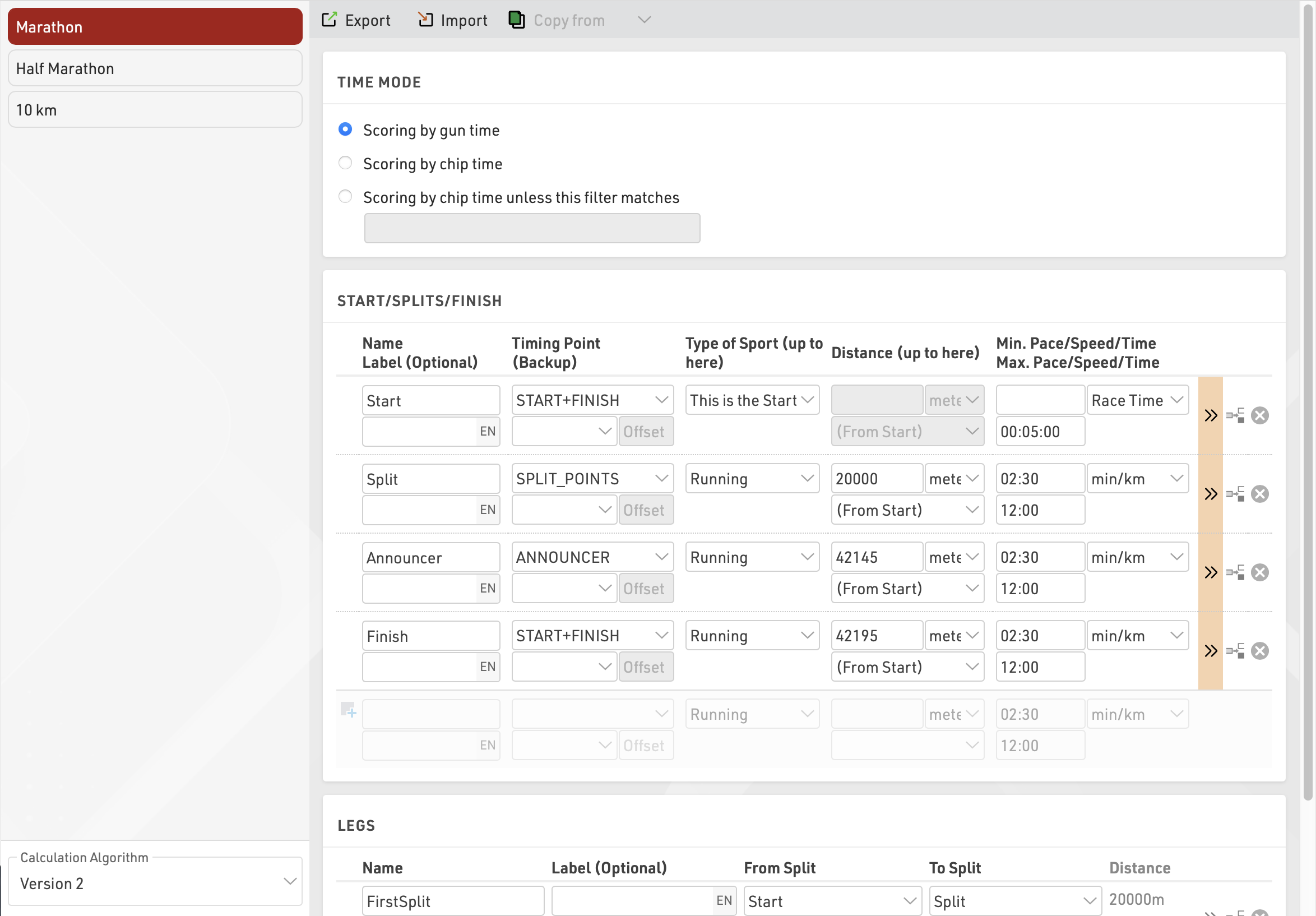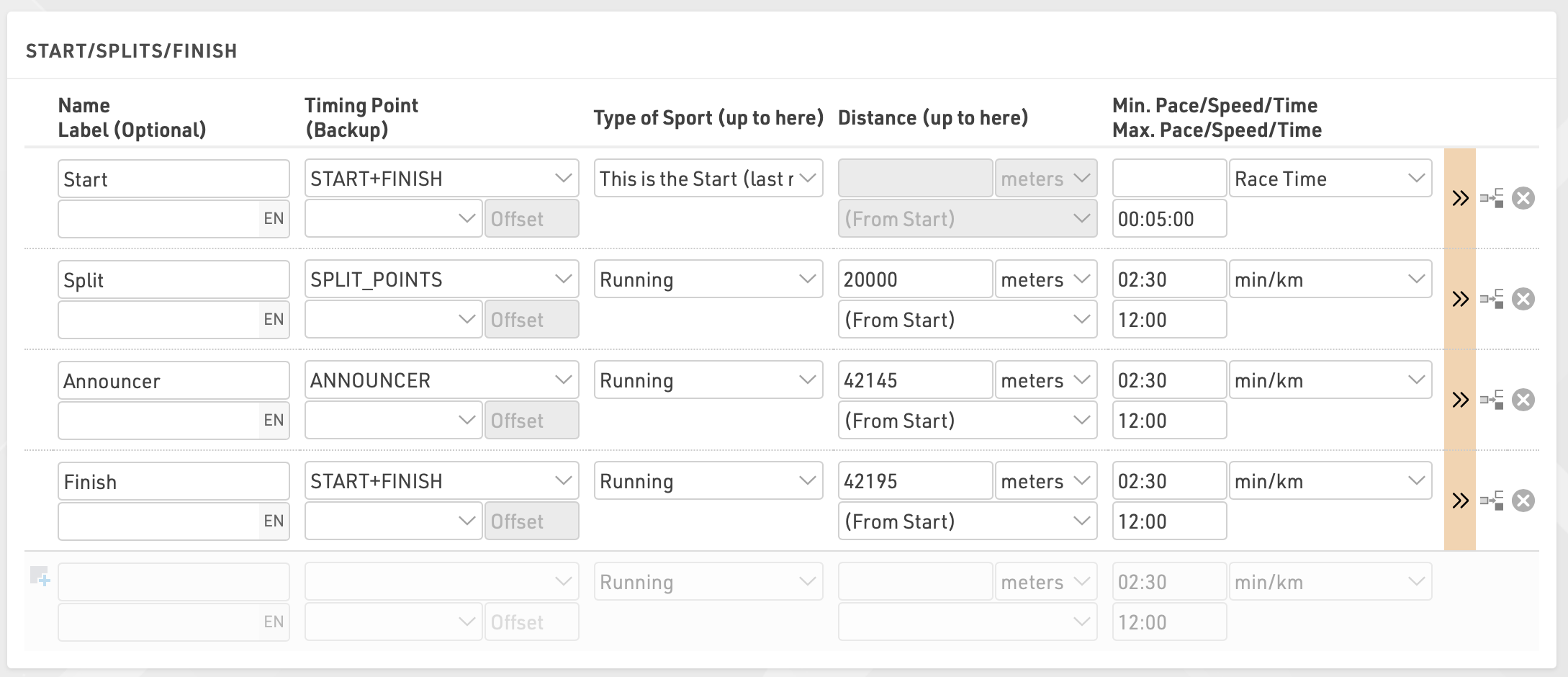Splits are defined for each Contest individually, allowing for an easy way of adding additional timing points to a particular contest and also defining contest specific rules where appropriate. Split setup can be copied from another Contest.

General Splits Setup
Time Mode
Each contest can be set to score by default using either Gun Time or Chip Time, setting this according to the contest allows for a simple output setup for final results.

It is sometimes necessary that certain groups of athletes, such as elites, are scored according to Gun Time but the main field should be scored on Chip Time. For this you can define a filter to be used for those who should be scored on Gun Time. Note that this filter will only work with fields which do not rely on Split calculations, as such it is not possible at this time to filter based on a Rank which relies on a Split Time.
For races where both time modes may be used both Gun and Chip time can still be called, see Split Fields for how to reference each.
Start / Splits / Finish
When setting up Splits for a race each split should have a unique name and then uses a few key settings to determine how a split time is calculated. Splits should be setup in their correct order on the course since this influences the calculations used.

Timing Point
Splits will only work with Timing Points which are set to Use Raw Data Only, since they can dynamically recalculate if new times or splits are added. A backup Timing Point can also be defined, so that if there is no time from the primary Timing Point selected then a backup time can be used, an offset either + or - can also be applied to the backup to account for the difference in time between the 2 Timing Points.
Note that 2 detections will be considered the same passing only if they are within 20 seconds. If the main / backup detections are greater than 20 seconds apart then they will be considered separately which may impact how Splits are calculated.
Type of Sport (up to here)
The type of sport serves 2 purposes.
Firstly it defines which splits are Pre-Start (Start Check) or the start detection. The split defined as the start is also used for the Chip Time calculations, if multiple starts are defined then the last one will be used. Normally the start detection should use the last read since participants may generate multiple passings whilst standing at the start.
Secondly by choosing a type of sport for a split then a Min/Max Pace/Speed/Time is automatically suggested based on the type of sport, each sport has a unique default suggestion.
Distance (up to here)
Entering a distance for the split aids in split calculations which rely on a Min/Max speed or pace, furthermore the distance for each split allows for automatic calculation of speed/pace for each split or leg.
Split distance can be defined as from start, from previous split or from a chosen prior split, there are also multiple distance formats which can be used (meters, kilometers, miles).
Min/Max Pace/Speed/Time
For each split the software must have a minimum time, for this there are multiple options on how this is calculated which may vary according to your personal preference.
- Race Time - Minimum and maximum race time for the split from T0
- TOD - Minimum and maximum Time Of Day for the split
- Time from Prev. Split - Minimum and maximum time from the previous split
- min/km - Minimum pace (fastest) and maximum pace (slowest) in minutes per kilometer
- min/mile - Minimum pace (fastest) and maximum pace (slowest) in minutes per mile
- min/100m - Minimum pace (fastest) and maximum pace (slowest) in minutes per 100m
- km/h - Minimum speed (slowest) and maximum speed (fastest) in kilometers per hour
- mph - Minimum speed (slowest) and maximum speed (fastest) in miles per hour
- m/s - Minimum speed (slowest) and maximum speed (fastest) in meters per second
- From Split "Split Name" - Minimum and maximum time from the selected split
Name / Label
Split names are used to call the Split fields, thus names cannot include special characters since this may cause ambiguity. The Split labels allow for any name to be shown in place of the Split name, and can also be translated in to multiple languages.
Advanced Split Settings
For each split the colour can be defined as well as a default Speed/Pace format. The format is set to Automatic by default which is then based on the type of Sport defined.
Legs Setup
In races with multiple splits it is often necessary to define specific Legs within the race, Legs may span multiple splits, distances or types of sport. Different Legs may even overlap where certain races require specific legs.
For example in a triathlon this may be swim/bike/run, or in a marathon it could be the first/second halves.
Each Leg is defined "From Split" and "To Split", this can use the Start Time (T0) or any Split already setup in the Splits table. Similarly a colour default Speed/Pace format can be defined in the advanced settings. Legs also have separate Name and Label fields to allow for custom labels and translations to be applied.

For each Leg the distance is automatically calculated, based on the distances defined for each split and Leg times / ranks / speed / pace will also be automatically calculated.
Algoritmo Intermedi
Quando si calcolano gli Intermedi, i tempi intermedi devono essere tra di loro sequenziali e quindi un tempo "più grande" non può essere utilizzato per un intermedio precedente, ma il modo in cui vengono gestiti i tempi e gli Intermedi dipende dall'algoritmo.
Versione 1
Questa versione dell'algoritmo considera sempre tutti i possibili Intermedi per i calcoli e il metodo di calcolo viene eseguito su tutti gli intermedi in sequenza per trovare la prima lettura chip corrispondente per soddisfare il calcolo del tempo intermedio.
Per ogni Intermedio viene calcolato un intervallo temporale valido in base ai valori minimo/massimo definiti per l'intermedio in esame ed eventuali intermedi precedenti già calcolati.
In questo metodo, un Intermedio precedente avrà sempre la priorità, quindi se un rilevamento viene mancato, ma una successiva lettura del chip viene registrata in questo punto di temporizzazione, ciò potrebbe causare errori.
Versione 2
Il nuovo algoritmo Intermedi viene eseguito invece su tutte le letture chip per il partecipante, nella loro naturale sequenza per trovare il primo intermedio corrispondente con un intervallo di tempo valido.
Quando viene abbinato ad un intermedio, tutti gli altri Intermedi (prima e dopo) ricalcoleranno i tempi validi in base ai valori minimo/massimo definiti per tale intermedio e gli intermedi attualmente calcolati.
In questo metodo, se è già stato calcolato un Intermedio, un intermedio precedente non verrà compilato da una successiva lettura del chip, tuttavia se vengono registrate letture del chip impreviste, ciò potrebbe causare errori.